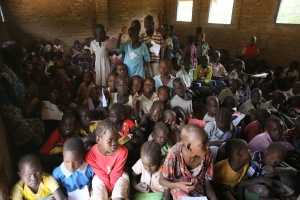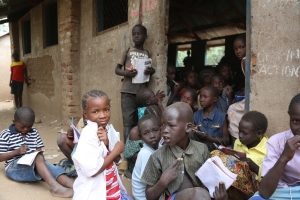Lokitang Primary School in Kakuma Camp emerged best in Kenya Certificate of Primary Education in Turkana West
The majority of the camp primary school candidates who sat for KCPE in 2011 performed very well compared to 2010 and past years. It came as a surprise when one of the camp schools, Lokitang Primary, emerged best in Turkana West District. For many years the camp primary schools had not performed very well in KCPE exams in Turkana but last year they amazed their counterpart Kenyan schools by beating them.
In the year 2011, thirteen primary schools in Kakuma refugee camp registered a total of 718 candidates for KCPE out of which only 163 were girls.
Many candidates scooped vacancies in good Kenyan secondary schools, while Kakuma refugee secondary schools used to be the only option for those pupils in the camp schools to compete for. Unlike other years, in 2011 many pupils successfully enrolled in secondary schools through self sponsorship, while Agencies have concentrated on girl child education. These children are not seen idling in the camp communities as has been the case in the previous years.
In the top 30 overall schools in KCPE 2011, at the camp level Mohamudi Hussein Saladi from Palotaka Primary School came first with total marks of 379. Uringi Munzila Sarifa from Angelina Jolie Girls’ Primary School came second with 372 marks, while Hussein Ali Dahiri from Fugi Primary School came third with 371 marks.
According to KCPE Performance Analysis for 2011 obtained by KANERE, the camp primary schools’ merit list indicates that pupils performed well in subjects like social studies and religious education, with total mean score of 60.36, while they performed poorly in Kiswahili with 41.83 mean score. The general mean score for 2011 was 259.61 compared to 238.80 in 2010; in other words, an improvement of 20.81 in the total mean score in 2011.
The better results were realized courtesy of the hard work, commitment and bee-like dedication from teachers, parents, all stakeholders concerned and learners themselves. “The good result was as a result of hard work. Our pupils were also serious,” the head teacher at Lokitang Primary told KANERE.

The sterling performance given by camp primary schools last year is all the more impressive given the challenges facing both primary and secondary schools in Kakuma camp. Classrooms are congested, desks are few and the population is overwhelming. Facilities are inadequate and resources have been scaled down. In general, both primary and secondary schools in the camp lack sufficient school supplies to the extent that teachers are lacking stationery to even prepare schemes of work and other professional records.
The situation in primary school is extremely bad. The lower primary classes are seated on the earthen floor while taking normal lessons in the school. The pupils take their lessons in congested classrooms with an enrolment of about 80–100 pupils per class in all camp schools. These are hindering factors leading to poor performances from both pupils and teachers. These pupils also leave the classroom very dirty at the end of the day, which can likely encourage poor hygiene and spread of communicable diseases.

In the camp there are three secondary schools: Kakuma Refugee Secondary, Somali Bantu Secondary, and Tarach Secondary School which only opened in 2011. Tarach Secondary is a public school and fees are paid for new admissions at this school. Somali Bantu Secondary only had up to form 3 this year and its first candidates for the Kenyan Certificate of Secondary Education (KCSE) will register in 2013.
Kakuma Secondary School has not performed well in recent years. In 2010 its general mean score was 4.7 while it deteriorated by 1.443 in 2011, which had a mean score of 3.257. Students from Kakuma Secondary are frequently seen in the morning around the neighboring primary schools, like Kaduguli and Shambe in Kakuma 1 zone 2 and 3 respectively, borrowing desks. Space is lacking at Kakuma Secondary and many students do not have somewhere to sit while lessons are going on inside the classrooms.
However, pupils from the 13 registered primary schools in Kakuma camp will compete for places at these secondary schools after the eight years course of primary education.
